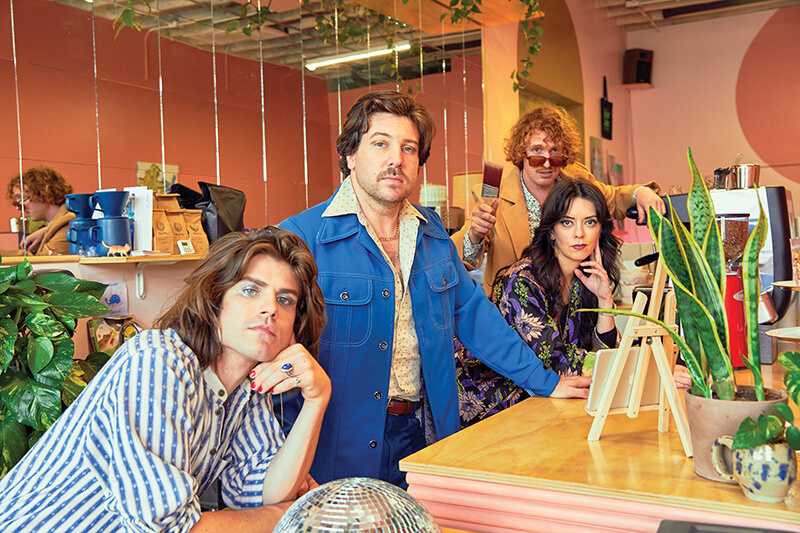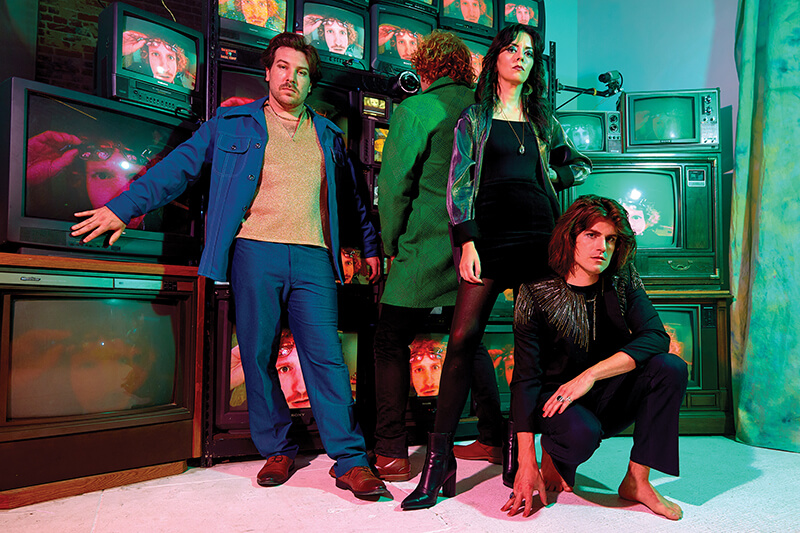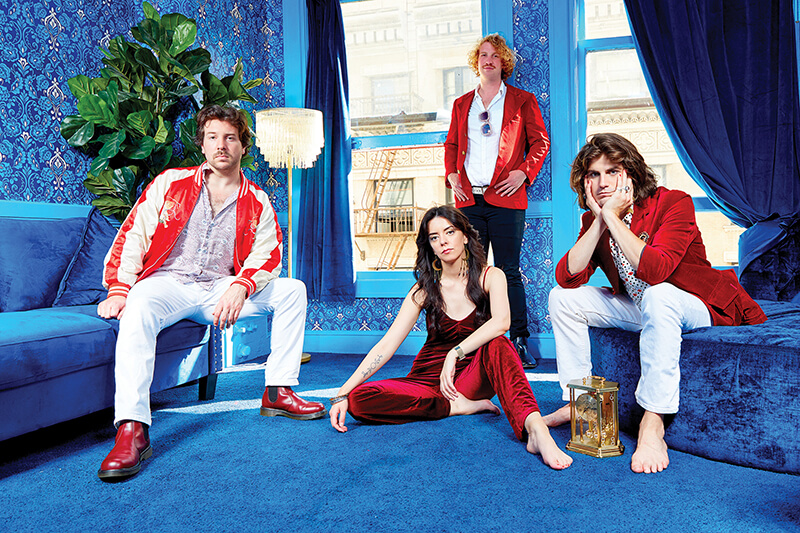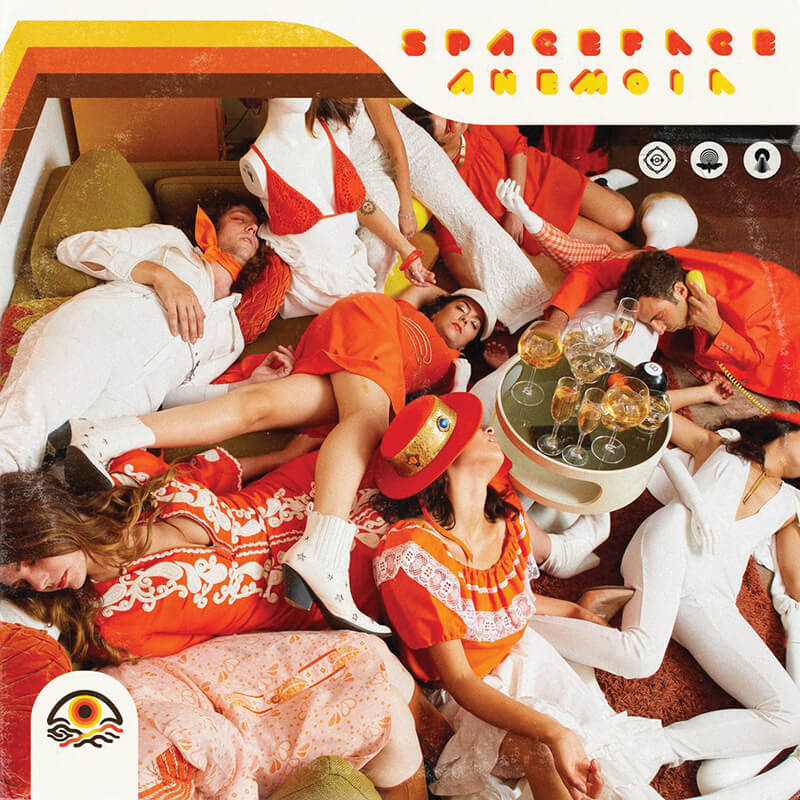Jake Ingalls is the Millennial textbook definition of a working musician: pragmatic and business-minded yet driven by a sense of romantic optimism. Naturally voluble and easy-going, Ingalls is the kind of person who’s unafraid of making himself the butt of a joke, so long as the payoff involves capturing the listener’s undivided attention. An obsessive multi-tasker, through the course of his career, he’s become used to having to wear many different hats. Raised in the musically rich city of Memphis, it’s there that he met fellow music enthusiasts Matt Strong and Eric Martin when the three of them were still a bunch of moon-eyed and ambitious high schoolers.
Influenced by the alternative, EMO, and punk movements of the early-to-mid aughts, they separately joined and founded several Memphis-area bands cutting their teeth at local venues. Over time, their musical paths eventually crossed again. After landing a gig touring as a roadie and backup guitarist for veteran alt-rockers The Flaming Lips, Ingalls joined forces with Strong and Martin in what, at the time, was supposed to be a temporary side project. Fast-forward a decade, two EPs, one full-length album, appearances at major music festivals like SXSW and Desert Daze, and a few personnel changes later, and the trio’s brainchild, Spaceface, seems far from calling it quits.
Following the departure of founding member Matt Strong and the addition of Katie Pierce, the group, which consists of Ingalls, Martin, and Daniel Quinlan, is set to release their second record, Anemoia, via Montreal-based record label Mothland. A fun and quirky homage to both ’70s funk and the neo-psychedelic movement, Anemoia aptly fuses luscious and painterly soundscapes teeming with an abundance of fuzz, phasers, and reverb with sultry and danceable grooves inspired by the likes of such soul pioneers as The Dramatics.

On a cold and sunny January afternoon, I caught up with Ingalls to discuss Spaceface’s constantly shifting identity, their new record, and his views on what the future holds for the group.
How did Spaceface come about as a project?
Matt (Strong) and I started playing guitar together back around the time that School of Rock came out. And I believe that’s when Eric started playing guitar too. Matt and I knew each other from school, and I knew Eric from playing hockey. After high school, we all sort of lost touch, and then at the University of Memphis, I ran into Eric and after hanging out for a while, we started jamming again. It was really amazing because not only was he really good, but he could also sing really well. He’s got a beautiful voice. So, we just started jamming. In the interim, I started roading for the (Flaming) Lips, and after doing that for a while, Wayne (Coyne, of the Lips) comes up to me and suggests hiring “one of those dorks from Spaceface” to play guitar in the band, which is when he got Eric in there for a bit.
You guys recorded your self-titled debut EP at Ardent Studios in Memphis back in 2014. Do you remember what that process was like?
We like to jam. We’ve never been the type of band to say “hey, let’s get together and play and write stuff.” That’s a nightmare to me. We’ve always sort of approached each other with chords and such and just jammed on that until we feel like we reach that point where we’re like “wait, stop right there, that’s a part,” and then we try to get whatever the next part would be going.
In some ways, that EP seems to carry parts of the band’s musical DNA in it. But in other ways, it sounds rawer and more akin to indie and lo-fi than the psych and funk of your later albums. Why do you think that is?
I’d say it was rawer because at the time we wanted to be psych-punk. There’s a big punk scene in Memphis and I think that’s just where we just saw ourselves fitting in. We wanted to be fast and raucous. And at the time I was also trying to play guitar in more of a percussive style and was influenced heavily by bands like Bloc Party. We also insisted that we record live, so when you have guitars just blasting in the room and into the drum mic you just can’t mix or edit around that, and you get a bigger rawer sound.
Which bands would you cite as an influence, both then and now?
Personally, I’ve always loved Bloc Party. I love how their guitars just play off each other. At that time, Eric was also really getting into Deerhunter and that was really big for us. Because Deerhunter is the first band that I’ve ever heard where they’re experimental and crazy but also just a garage band.

There is a three-year period between your EP and your first LP, Sun Kids. How did you spend that time? Did you concentrate on songwriting and working on your sound, or did you opt to hit the road and start touring?
We definitely did tons of touring between those two records. At that time, I was also on the road with the Lips, so I didn’t have much time to record stuff. On the one hand, I feel fortunate that we got to build a solid fan base across the U.S. because we toured so much. But on the other, sometimes I wish that we’d just kept recording, especially because we were already playing most of the songs from Sun Kids. At a certain point, you kinda think “maybe we should record these so people know all these songs.”
By the time we get to Sun Kids, the sound seems to be more polished and refined. I feel like this is where you guys dive headfirst into a spacier, more psychedelic, and folkier phase. What prompted that stylistic change
I think it was unsustainable to keep playing the kind of fast-and-heavy stuff we had on the first EP. We wanted to make Sun Kids feel fuller and more complete. We wanted some songs that you could groove and dance to and others that you could just vibe to. We wanted to slow down and also showcase what it’s like when we’re home sitting on the porch and just playing acoustically. We tried to emulate what it felt like to be with us, at home, in Memphis. I also think that there’s a more relaxed and natural side to the psychedelic experience that happens when you’re outside that’s full of cinematic moments. Whenever we would talk about the record we’d say, “this is the part where you get in the car and turn on the stereo and start the day.” So, in a way, our approach was also more cinematic.
On your newest album, Anemoia, the musical shift seems to be towards funkier pastures while retaining some of the early psychedelic vibes. How did you decide to fuse both of those styles?
We just wanted to make a record that you can unabashedly put on at a bar and play from beginning to end. This was also made at a time when we lost members of the band and I’d just moved out to L.A. and decided to book studio time just to keep the ball rolling. My producer Jarod came up and told me to write down a list of stuff that I liked or was into at that moment. So, I put together a bunch of old funk like The Dramatics and South African funk and such. And I remember Jarod asking me why the music I made didn’t really sound like the music I liked.

Where and when was this album recorded?
We actually started the record pre-Covid, it was actually pretty much done in 2019. The reason “Panoramic View” came out so early was because we had an opening slot with White Denim and had learned over the years that we should probably be promoting something when playing live. So, we put that out thinking that we could get the record out in 2020 but then the pandemic happened, and we ended up just sitting with it. Parts of it were recorded in Memphis with Calvin Lauber who’s done stuff with Juliene Baker. But most of it really was truly recorded from scratch at Blackwatch Studios in Norman, Oklahoma. I think that there are a couple of things we recorded with my friend Taylor Johnson in Oklahoma City, and maybe a thing or two recorded out here in L.A. But the bulk of it really was done in Norman.
You guys seemingly have a knack for making pretty eye-catching music videos. “Long Time,” “Happens All The Time,” and “Rain Passing Through” all feature vivid colors and lean heavily into psychedelic themes and absurdist narratives. How do the ideas for these usually come about?
For “Long Time,” I bought the LED mask on Etsy, and I knew that I wanted a robot character in it. Our current bass player does a lot of VHS stuff, so we had her shoot me playing a bunch of different characters with the robot mask in front of a green screen. That eventually evolved into getting two of our friends to come dance for it. Usually, I just come up with a couple of things and reach out to anyone I know that might be the best person to work on it with. For “Rain Passing Through,” my friend Connor had shot the stuff in the shower and then suggested I look up royalty-free stock-footage sites for images that might match the color palette. I did, and then sent that over to my friend Mack Hanson who’s an expert editor, and he just turned it into a story. So yeah, I usually just like to work with people that I know and that I like, and that I feel comfortable collaborating with. I just set the template and then just give them free rein and it works.
Once the new record comes out, are you guys hitting the road? What does this year look like?
Because we’re older and most of us have jobs and whatnot, we’re doing what I’m referring to as Little Battles rather than waging a Full War. We have a tour with Reptaliens, we’re co-headlining with them. That starts [this month] in San Diego going up the West Coast. We’re actually going to be playing The Echo (in L.A.), which I’m really stoked about because I grew up watching videos of awesome bands that I love playing that venue so I’m really excited. So, we have a West Coast run followed by a month off. Then we have a run going out East around March and April to play Norman Music Festival on the way to Nashville, Atlanta, and New York all the way up to Montreal. And finally, around July and August, we’ll do a Midwest run through Chicago and down to Texas later in the year. So, it’s a bunch of touring but broken up into smaller tours a few weeks at a time. And I’m sure we’ll also end up doing a New Year’s show.

Any artists that you would like to collaborate with in the future?
I’d love to work with Teebs. I’ve actually reached out to his people about working together, I just love his cerebral stuff. Melody’s Echo Chamber, I’ve actually talked to her a little bit on the internet, but it hasn’t quite panned out yet. And then I was talking to someone in Superorganism and traded tracks with them. I have to hit them up because I would love to do something with them. And then, I was supposed to have Eric Slick play on some tracks. It didn’t happen but still would love that. And yeah, probably James or any of the guys from White Denim.
Follow on Instagram @spacefacemusic
Photos by Erika Mugglin
